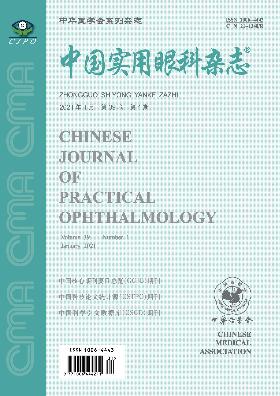Exploration of the preventive effect of triamcinolone acetonide on posterior capsular opacification
引用次数: 0
Abstract
Objective To investigate the preventive effect of low concentration of triamcinolone acetonide injected in anterior chamber on posterior capsular opacification. Methods A prospective clinical randomized controlled study of 120 patients with age-related cataract which diagnosed in Department of Ophthalmology of Zhongnan Hospital of Wuhan University were selected from March 2013 to March 2014. A total of 120 cases (120 eyes) were randomly divided into two groups and performed cataract phacoemulsification. The experimental group was injected triamcinolone acetonide (4 mg/100 ml, 0.2 ml) in anterior chamber after cataract phacoemulsification while the control group was injected sodium chloride (0.9%, 0.2 ml) in anterior chamber after operation. Postoperative follow-up 36 months, the incidence of postoperative posterior capsular opacification, early preoperative inflammatory response, intraocular pressure and corneal endothelial cells count in the two groups were observed. Results All 112 cases (112 eyes) were completed and included in the clinical analysis, including 54 cases (54 eyes) in experimental group and 58 cases (58 eyes) from control group. In the 3, 6, 12, 24 and 36 months after surgery, the incidence of postoperative posterior capsular opacification in the experimental group was lower than that in the control group (χ2=4.038, 7.377, 5.255, 4.809, 4.127, P 0.05). Conclusions Anterior chamber injection of low concentration of triamcinolone acetonide is an effective and safe way which can reduce and prevent the incidence of posterior capsular opacification and delay the onset of posterior capsular opacification after cataract phacoemulsification. Key words: Posterior capsular opacification; Triamcinolone acetonide; Intraocular pressure曲安奈德对后囊膜混浊预防作用的探讨
目的探讨低浓度曲安奈德前房注射对后囊膜混浊的预防作用。方法选取2013年3月至2014年3月武汉大学中南医院眼科诊断的120例老年性白内障患者进行前瞻性临床随机对照研究。120例(120眼)随机分为两组,行白内障超声乳化术。实验组患者白内障超声乳化术后前房注射曲安奈德(4 mg/100 ml, 0.2 ml),对照组患者术后前房注射氯化钠(0.9%,0.2 ml)。术后随访36个月,观察两组患者术后后囊膜混浊发生率、术前早期炎症反应、眼压及角膜内皮细胞计数。结果112例(112眼)全部完成纳入临床分析,其中实验组54例(54眼),对照组58例(58眼)。术后3、6、12、24、36个月,实验组术后后囊膜混浊发生率均低于对照组(χ2=4.038、7.377、5.255、4.809、4.127,P 0.05)。结论低浓度曲安奈德前房注射是一种安全有效的方法,可减少和预防白内障超声乳化术后后囊膜混浊的发生,延缓白内障后囊膜混浊的发生。关键词:后囊膜混浊;去炎松醋酸酯;眼内压
本文章由计算机程序翻译,如有差异,请以英文原文为准。
求助全文
约1分钟内获得全文
求助全文
来源期刊
自引率
0.00%
发文量
9101
期刊介绍:
China Practical Ophthalmology was founded in May 1983. It is supervised by the National Health Commission of the People's Republic of China, sponsored by the Chinese Medical Association and China Medical University, and publicly distributed at home and abroad. It is a national-level excellent core academic journal of comprehensive ophthalmology and a series of journals of the Chinese Medical Association.
China Practical Ophthalmology aims to guide and improve the theoretical level and actual clinical diagnosis and treatment ability of frontline ophthalmologists in my country. It is characterized by close integration with clinical practice, and timely publishes academic articles and scientific research results with high practical value to clinicians, so that readers can understand and use them, improve the theoretical level and diagnosis and treatment ability of ophthalmologists, help and support their innovative development, and is deeply welcomed and loved by ophthalmologists and readers.

 求助内容:
求助内容: 应助结果提醒方式:
应助结果提醒方式:


